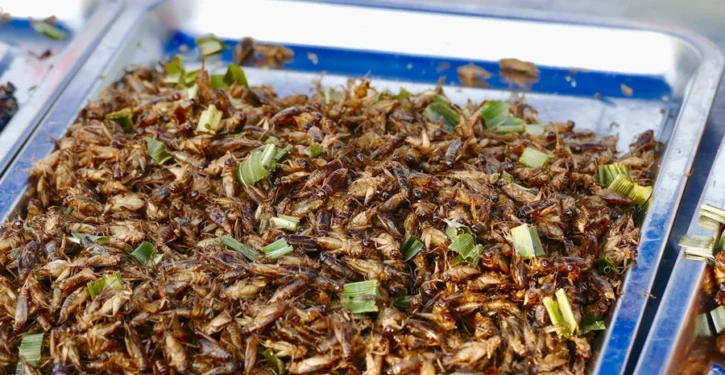
The United Nations is encouraging people to eat more bugs. It hopes the world will add insects to lots of dishes, they way people do in northeastern Thailand, where people
consume bugs the way Americans eat potato chips. They are served at breakfast, lunch and dinner and often carried around as a midday snack… The main feature was ant eggs. In both the markets I visited, hundreds of the pearly white nuggets were fanned out on banana leaves or plates and sold for 100 baht ($3) per plate….
Mahnoi Food Lab experiments with fermenting different creepy crawlies in large glass jars that stew in the heat and slowly turn into pungent liquids. Often, the results are incorporated into the menu at Samuay & Sons or distributed to other restaurants around the country….
Isan is historically poorer than most of the rest of Thailand, and insects have long been a staple in the local diet as a result. They cost nothing to capture and are a cheaper source of protein than pork or beef. “In the northeast area of Thailand, people eating insects is the culture. It’s normal.” “People eat anything that moves.” “We are so related to what nature gives us in each season.” Most people toss ants into a stir fry. Or a tom yum soup, for extra flavor. The ants are acidic, with a sharp, sour tang, offering an alternative to lime.
In a world where temperatures are rising, could such a tradition of eating insects spread elsewhere? The United Nations Food and Agriculture Organization hopes so. It has been encouraging people to eat insects since at least 2003… insects act as a source of fat, vitamins and minerals. A couple handfuls of crickets, for example, contain almost 30 grams of protein, more than in a chicken breast…. local governments across Thailand [are working] on school meal projects that integrate the likes of beetles and mealworms into Thai dishes, hoping that targeting young children could help change attitudes in parts of Thailand less exposed to insect-eating….
Part of the challenge is tackling the idea that insect consumption is only for poor communities. That’s where high-end chefs like Num come in. They are able to elevate local cuisine and showcase innovative new recipes, giving bugs an upgrade into the fine dining world rather than leaving them out in night market food carts….crafting one of the 20 insect tasting dishes he has on his menu.
Most — such as subterranean ants, which Ou describes as tasting like Parmesan cheese, and cockchafers — are simply fried in their own fat on an open flame and served with nothing but a sprinkle of salt. Some, however, such as young cicadas or crickets, are ground using a mortar and pestle — it’s an appliance-free restaurant — to make a relish that will accompany a basket of leafy greens.
To provide more protein for a world with a growing population, scientists are developing meat alternatives such as maggot sausages, the New York Post reports:
Food scientists at the University of Queensland in Brisbane, Australia are incorporating insects such as maggots and locusts into a range of specialty foods, including sausage, as well as formulating sustainable insect-based feeds for the livestock themselves.
“Would you eat a commercial sausage made from maggots?”, asks a meat science professor. “One of my students has created a very tasty insect ice cream.”
Insect protein is certainly healthy, and insects are low in fat. Actress Nicole Kidman eats raw insects—such as mealworms, horn-worms, and crickets—and claims that they are tasty.
Not all insects are boring to eat. Some are tasty even without seasoning, such as the periodical cicadas that come out of the ground in huge swarms once every 17 years in many eastern states. If you microwave cicadas for a short time, they become quite tasty and meaty. They can also be put in salads, pastas, and risottos, just the way chicken can. Even eaten raw, they are mildly tasty.
Kidman says “two billion people in the world eat bugs.” In southern Africa, people eat stinkbugs as a nutritious snack.
Periodical cicadas are an obvious food source because they make little effort to evade capture, do not fight back, and can easily be collected in plastic sandwich bags. They emerge from the ground in huge broods for a period of several weeks, after spending many years underground (10, 14, or 17 years, depending on the region).
After they emerge, they are devoured with abandon by dogs, rodents, and adventurous people. Dogs that spend most of their time outdoors love eating cicadas so much they often end up getting constipated as a result of their feast on cicadas.
Kidman says “two billion people in the world eat bugs.” In southern Africa, people eat stinkbugs as a nutritious snack.



